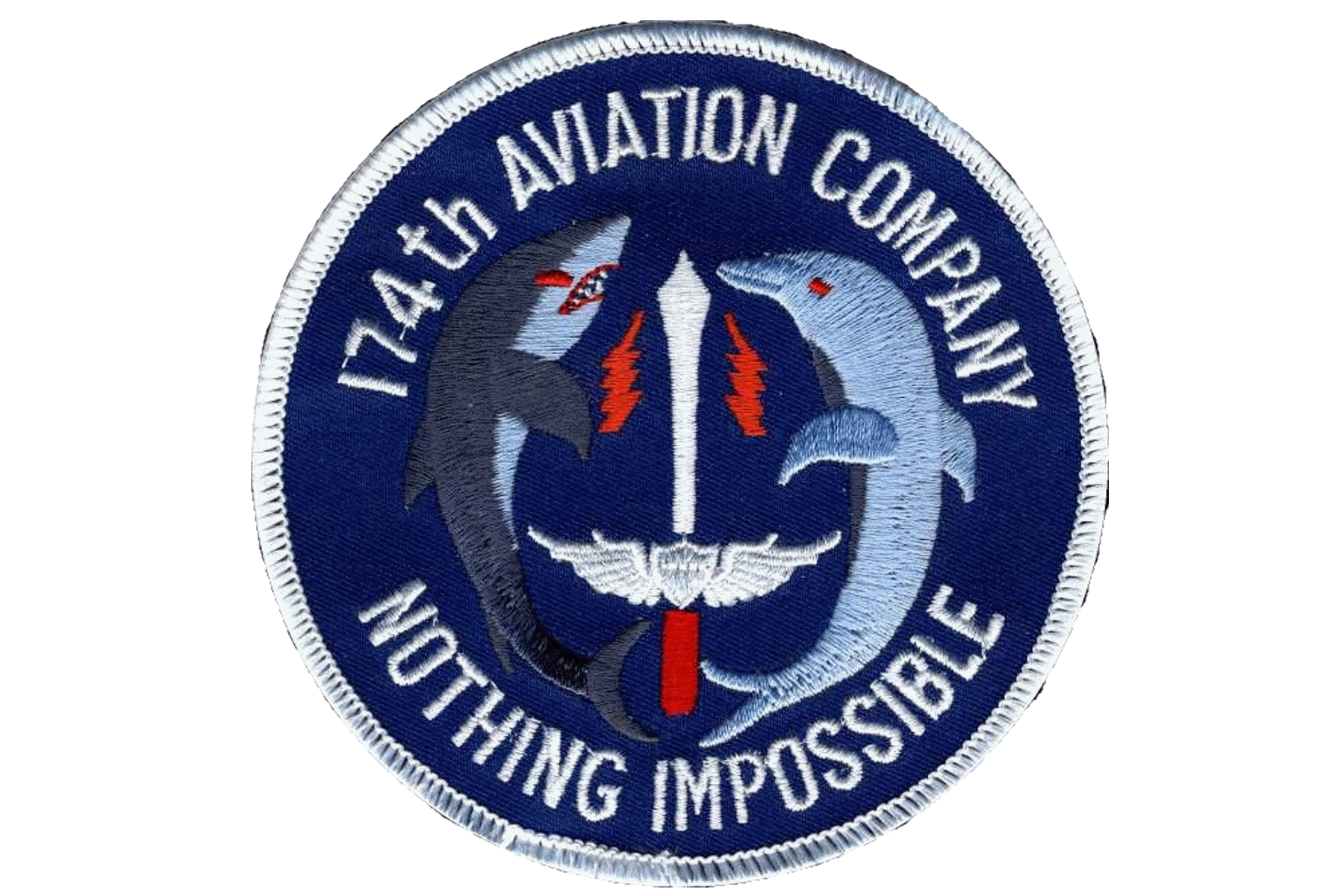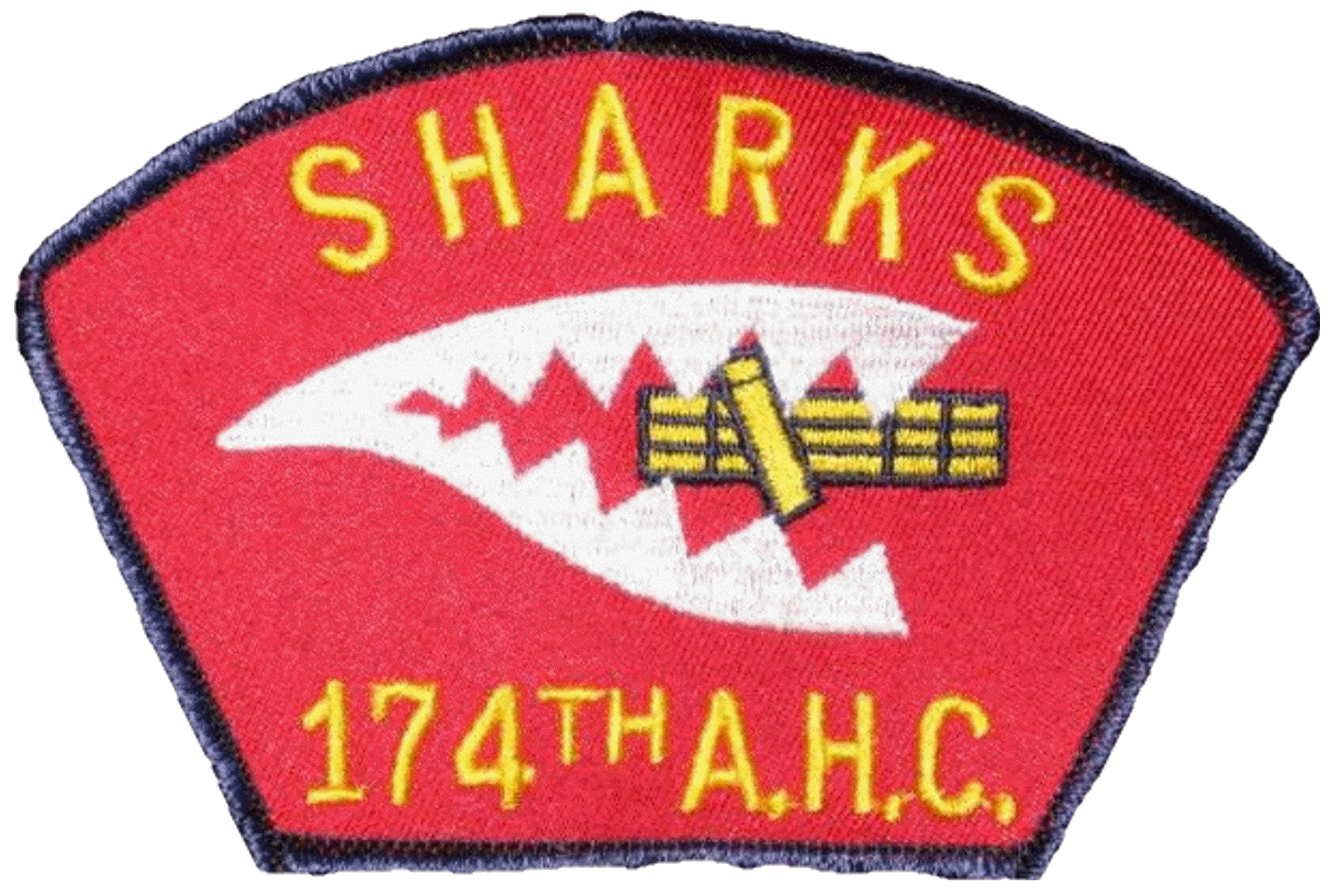Prologue
The following was written by Dick Overhamm, a former major with the 174th Assault Helicopter Company from 15 November 1965 to 23 September 1966, at Fort Benning, Georgia and in Vietnam. This was written at the recent request of Bernie Cobb, who was also with the 174th from the beginning until the summer of 1966. Former Major Cobb was the first Shark 6 in command of the 174th Gunship Platoon. The two section leaders were Major Dick Overhamm and Major Bob Jones.
Having just established communications with Overhamm in early 1999, after thirty-three years of not hearing from each other, Cobb asked Overhamm to recount his personal efforts in obtaining permission from the famous pre-WWII Flying Tigers to use the same sharks teeth painting on 174th armed helicopters, along with other recollections of his early days in the 174th AHC. Previous "recollections" had been provided Marty Heuer to assist him in his 174th historical project which also reflects these dates and types of aircraft.
Here is that account as Dick Overhamm wrote it (with concurrent input from Jack Hester, Charlie Gregorski, John Pum, Jim Coyne, and Gene Teague):
174th Aviation Company (Airmobile) is activated at Fort Benning, Georgia on 1 October 1965. Personnel begin to arrive 1 November 1965. The unit is organized into two lift platoons of eight UH-1Ds each, one armed platoon of eight UH-1C "540" rotor system, and a service platoon to which one of the UH-1C aircraft is dedicated.
The designation of UH-1C "540" has been argued recently to which I'd like to add the following: The previous B models were similar only in their fuselage configuration. I cannot recall a C model manual (I may have one squirreled away in a footlocker) but my C model checkout at the Bell Plant is dated 8 October 1965. I became a C Model IP (Instructor Pilot) subsequently while assigned to the 5th Special Forces Group at Fort Bragg, and my flight records were annotated UH-1C and also UH-1B "540." This Huey version had an L-11 engine, a redesigned rotor system with Teflon bushings (CAUTION! Keep Clean!), a 27 inch main blade chord, and a 120 knot plus airspeed. The extra 77 gallons of fuel increased flight time to three hours, dual hydraulic reservoirs separated guns from pedals, and maximum gross weight was increased to 9500 lbs. The autorotational characteristics were greatly enhanced by the increased inertia of the larger rotor blades. As a gunship it was "hot" for its time, and gunruns pushed the redline - a temporary advantage until Charlie figured out a new lead factor. The Army procured 767 "C" models between 1965 and 1967. The AH-1G "Cobra" with an L-13 engine replaced the UH-1C which, in turn, gave way to the Apache. Watching an Apache demo causes old gunship types (like me) to salivate.
(NOTE: This and all photos on this page are thumbnails.
Click on the thumbnail to see an enlargement of the photo.)
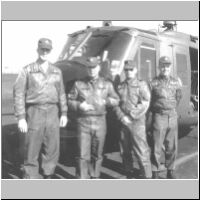
Transistion to the UH-1 at Fort Benning 1965.
L-R: Dick Overhamm, Bob Jones, Dale Wylie and unknown officer.
Photo courtesy of Bob Jones.
The 174th Assault Helicopter Company was alerted for a PCS (Permanent Change of Station) deployment to USARPAC on 8 December 1965. Personnel and equipment came together in earnest now, intensive training began, and preparation for overseas movement was completed by the end of February 1966.
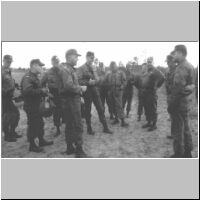
Photo taken during a Ft. Benning field exercise 1965. Far left is Dick Overhamm, center left is Cliff Walker, to Cliff's left is Jim Shrader, to Jim's left is Bernie Cobb and Bob Stuart (our CO) is right center with hands on his hips. Photo courtesy of Bob Jones
The time spent at Fort Benning involved some serious scrounging to cushion the probable rough times ahead. Rumors envisioned the unit being deployed in the boonies of RVN (Republic of Vietnam) a la the 1st Cavalry Division at An Khe, i.e., hack out a clearing in the jungle and start from scratch. Little did we know we would end up at Lane Army Heliport, a relative lap of luxury.
Accordingly, the biggest scroungers set out to pillage various sources for goodies; the Benning Post Engineer and the salvage yard, the Disposal Office at Warner-Robins Air Force Base, Georgia, and my contacts at Fort Bragg, North Carolina, where I had just left the 5th Special Forces Group.
Captain Dick Smith's father was a director in a multi-state refrigeration dealers association. He tapped his contacts while we scrounged for used refrigerators and water coolers which were overhauled by various agents for us. Some were outright donations of new units for "the boys going to Nam." (Marty Heuer mentions this in his manuscript.) Unfortunately, Dick Smith transferred out of the 174th during the big DEROS (Date of Estimated Rotation/Return OverSeas) swap. I am unaware of his current whereabouts.
Major Bob Jones, aka, "Ole Curly" due to his glistening dome, pulled off a classic. He located a salvaged 100KW generator in the McClelland Air Force Base scrap-yard. He arranged to have it shipped out to Sacramento Army Depot, California (his former duty station) and had it completely refurbished by his former contacts. Then he finagled the necessary documentation to ship it to Oakland and loaded aboard the USNS Upshur. It arrived at Lane AHP and served up to the time some dummy screwed up on the lubrication schedule. For a Signal Corps type, Ole Curley done good! Damn good!!
Captain Gene Teague and myself, both accustomed "to existing off surplus items by transferring equity (inventory)" in previous career assignments, concentrated on usable essentials such as chainsaws, lumber, pipe and plumbing accessories, basins and small sinks, folding tables, electrical cable and accessories, and pedestal-mounted fans. The truly unusable fans were traded off with similar winterized items in various mess halls, the rational being, "who needed them the most." Latrines were fabricated as collapsible three-holers with seats, and suitably painted in horizontal red and yellow stripes, appropriate for our ultimate destination!
However, the best item obtained was a heavy, dense, fiberglass composition board deemed suitable for armor plate. Tests were conducted at Benning with various caliber pistols and rifles, i.e., .38, .45, .30-.30, and 7.62 mm at ranges from 100 feet to 200 yards. If the round wasn't deflected, stopped, or absorbed, it was slowed down significantly. At any rate, it sure beat Plexiglas and aircraft skin for protection. We secured a stack of these 30" x 30" sheets from Warner-Robins and proceeded to use up band saw blades in the Fort Benning hobby shop. The resulting H-shaped floor boards protected the forward aircraft floor areas. Rectangular pieces were used to protect the rear crew seat areas.
The 174th vehicles and heavy equipment, to include scrounged goodies, were processed by Major Jim Hayes, the Motor Pool officer, loaded aboard the African Glen at Charleston, South Carolina, and shipped to RVN, accompanied by Captain Arthur P. Wright of the 174th AHC acting as OIC (Officer in Charge).
Unit aircraft were ferried from the Bell Plant in Texas to Oakland, California for loading aboard the USS Point Cruz, a WWII vintage baby flattop. The 174th was blessed with new aircraft - UH-1Ds and UH-1Cs with the 540 rotor system.
The 174th AHC main body departed Columbus, Georgia by commercial air on 15 March 1966 for Oakland, California and subsequent boarding on the troopship USNS Upshur. (This phase is detailed in Marty Heuer's manuscript extensively.)
The 174th AHC advance party departed Fort Benning, Georgia two weeks later for RVN by commercial air.
The USNS Upshur departed Oakland, California on 16 March 1966 with stops enroute in Hawaii, Okinawa, and Japan. The troopship arrives in RVN on 7 April 1966.
The USS Point Cruz departed Oakland, California on 18 March 1966 with eighty-four helicopters aboard and a selected group of aviators (gunship pilots) and technicians. The voyage was extended by a day when the ship snagged a cable in San Francisco Bay - an omen of a voyage to come! We finally clear the Golden Gate Bridge on 19 March 1966. A change of destination was received enroute directing us first to Vung Tau instead of Qui Nhon, RVN. All the aircraft had been stripped of their protective cocoon material as we transited the Philippine Straits. Since the aircraft were stacked to the maximum on the flight deck, the honor of trying not to nick the first tail rotor was delegated to me since I was an IP. Off-loading proceeded without incident in spite of everyone being a bit rusty and operating from a pitching deck. Gene Teague's maintenance background gave us the necessary knowledge to cope with the JP-5 hot starts.
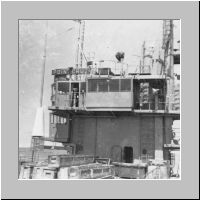 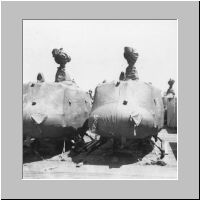
Left: Bridge of the aircraft carrier USS Point Cruz. Right: 174th AHC UH-1s on the carrier's flight deck. Note the "skin tight" wrap to protect them from "elements" while at sea. Both photos March 1966 courtesy of Ted Saunders
Gene Teague recently added the fact that a property book adjustment of assigned aircraft serial numbers corrected the loading sequence problem caused by the change of destination. The aircraft flown off and parked on the Vung Tau airfield, previously assigned to the 174th, now were destined for the 25th Infantry Division. The 25th Division aircraft remaining aboard the Point Cruz were subsequently transferred to the 174th. The short run from Vung Tau to Qui Nhon was another intensive period of aircraft preparation.
Coincidentally, my first assignment out of Flight School was the 25th Aviation Company, 25th Infantry Division at Wheeler Field, Oahu, Hawaii.
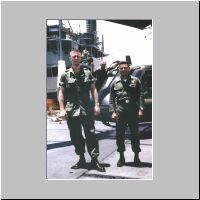
This photo was taken on the 6th or 7th April 1966 while we were at anchor in Vung Tau. That's Gene Teague waving his hat. The guy on the right is WO2 Richie Delconte- Toni's cousin! He introduced us at Ft. Bragg in '65. That would be me on left.
During all this activity, the jittery Maritime Service crew was pitching grenades overboard to discourage those VC frogmen (there ain't none). The off-loading operation gave us a chance to down a few cold brews at the Pacific Hotel in Vung Tau. Having survived a previous tour in the "Pearl of the Orient," I knew where to go after a long dry spell to kill a cold six-pack. The Point Cruz finally arrived in Qui Nhon on 9 April 1966. Since the ship was destined for dry-dock upon returning to CONUS (Continental U.S.), the chief engineer gave the scroungers the green light, partially out of sympathy and partially out of the crew's dislike for the Captain. If a desired item wasn't welded to the ship or absolutely essential, it wound up in an aircraft. While these were among the first UH-1C aircraft to be employed in RVN, they certainly presented some unusual modifications! The ship's "salvaged" fire hose became our initial water line to the company shower point.
The African Glen arrived in Qui Nhon, RVN, on 11 May 1966, with vehicles and equipment for the 174th AHC and the 409th Detachment. Unfortunately, due to a loading snafu back in Charleston, South Carolina, most of the items scrounged earlier at Fort Benning and Warner-Robins were missing! The 174th OIC, Captain Arthur P. Wright, was included in the subsequent DEROS transfer and was assigned to the 161st AHC. Subsequently he became the first 174th member casualty on 17 May 1966. He was a great guy. The former 174th Motor Pool officer, Major Jim Hayes, was also transferred in the DEROS swap.
The transfers under the DEROS plan are initiated on 11 April 1966. We lose some good people and gain some experience, transferred in with the 161st AHC folks. The unit remained O-4 (rank of Major) heavy with several promotable to 0-5 (Lieutenant Colonel). The 174th is a "Major" unit with a tremendous skill level. Rank for the most part is set aside and everyone bent to the job of improving the area. I can recall building the company shower point and the gunship revetments with their ammo storage points, as well as the big H shaped officers hootch on top of the hill overlooking the 174th area.
The first night gunship mission was scrambled on or about 8 May 1966 involving three UH-1Cs, a response to an American advisor and some 22nd ARVN (Army of the Republic of Vietnam) troops being clobbered on the north slope of the Phu Cat Mountains. Among the crews, I believe, were the gunship platoon commander, Major Bernie Cobb, Jones, Teague, Wylie, and myself. We flew totally blacked out- only the aft engine stack glow was visible- in a daisy chain with one Shark on the break, one downwind, and one on final. The five- in- one tracers were adjusted by the advisor on the ground with rockets following. It was as if you were flying into an ink well. The folks on the ground were desperate. It was HAIRY! At daybreak the unit was extracted. The VC body count was 29, some of whom must have met the Great Buddha as a result of our action.
The 174th AHC is declared operational (combat ready) on 12 May 1966. The night gunrun four days previously was obviously only a practice drill! We became OPCON (Operational Control) to the newly- formed 14th CAB (Combat Aviation Battalion) at Lane on 24 May 1966. On 1 June 1966 the 174th is totally separated from the 52nd CAB at Pleiku. The previous command arrangement made for some trying liaison and questionable missions.
During our two-man tent housing era, and simultaneous with the ongoing construction to improve living conditions, events occurred, which to this day bring to memory smells and laughing akin to fear. None of us will totally forget the daily ritual of burning the latrine "honey pots" with JP-4 (jet fuel). The ensuing smoke and smell were something matched only by the frequent use of our red- and yellow- stripped "three holers" to ward off the RVN six-week bug.
One of the infamous three holers was dedicated to the Vietnamese hootch maids. It was located near the 100KW generator in the motor pool area. An incident one afternoon created quite an uproar. A big Cobra had entered the mamason's latrine causing two of them to exit with pants at half mast and screaming at the top of their lungs. One of the enlisted folks tried to kill it with his M-16 rifle but that only infuriated the reptile causing it to thrash about like a loose high pressure fire hose. It finally met its demise when Chinch Wollerton of the gun platoon and a member of the "High Priced Help" dispatched it with his .45 cal. pistol. Someone skinned it and draped it over a 1" x 12" board. The trophy's length was in the range of 10 feet 9 inches if I recall correctly. We were all aware of the deadly little pale green Bamboo snakes but this cobra brought a new dimension to our in-country orientation.
Sometime after becoming operational and while we were still in two-man tents, the idea of going for a swim in the nearby stream in the ROK AO (Republic of Korea's Area of Operation) and washing some dirty clothes became very appealing. Another consideration was the Teflon in the 540 rotor system. A clean aircraft and rotor head improves the maintenance profile considerably. Accordingly, a bunch of Sharks climbed aboard a gunship with M-16s, buckets and filthy duds, and we headed for a nearby sandbar and swimming hole. With security rotated on the bank we washed the aircraft, our clothes, and took a swim. We flew back to Lane in boots, shorts, and helmets. Upon landing we were met with some disapproval. However, we were not the last to visit the swimming hole.
Bob Jones and I shared a tent along with a pet toad and a few lizards to eat the insects, which in turn were trying to devour us. One exceptionally well moon-lit night, I was responding to a call from Mother Nature as a result of a few beers (guilty to this day). As I returned slowly and quietly through the tent entrance, a quiet, somewhat feeble voice called out, "Dick, is that you?" Apparently my tall frame silhouetted by the moonlight caused my roommate some anxiety. We slept with our sidearm ready and after that night we awoke the other guy when one of us tended to business. Better safe than sorry. After all, we were no different than other victims of VC infiltrators. Major "Ace" Drummond of the 48th AHC had been stabbed four times in the chest while he was prone in his tent. Does anyone know of Bob Jones whereabouts now or what has become of him? (Note: Dick found "Ole Curly", just prior to the October 1999 Reunion of the 174th AHC Association, through efforts of the USAA insurance locator. In spite of recent open heart surgery, Bob did attend the Reunion with his wife Mary.)
Other gunship missions were flown in support of ROK and ARVN combat assaults, as well as, individual missions for two or three gunships on a temporary basis at An Khe, Dak To, Pleiku, and other garden spots. Things were normally cut and dried - almost ho hum. But not for too long.
On 3 June 1966, during one post-CA resupply period, the slicks were coming under fire when landing at one of the ROK outposts. Captain Buck Griffin, on one of his resupply runs, deposited Major Bernie Cobb and a radio operator. Being on the ground, Cobb could better ascertain the origin of the sniping. Meanwhile, two Sharks were orbiting overhead, hidden by a broken cloud layer. Cobb determined a heading and a probable distance to the target. We contacted Qui Nhon to determine local air traffic since we were near the approach path from An Khe. Once cleared, we ducked into the cloud bank, got on heading, and began a decent. We got lucky and broke out in the clear and on final to the target. A couple pairs of rockets did the job. Jones and I were part of the crews involved. (Check with Wylie, Teague, and possibly P. T. Yowell, also). The enclosed news article was accurate except for the error, i.e., 17th instead of 174th. "My lucky day - cut a palm tree down with a rocket! Charlie was dug in at the base of the tree with an automatic weapon; used to be!" was a scribbled footnote to the clipping sent home to Toni Overhamm and retained by her. It refers to that gunrun and is on the 174th AHC Web Site. Bernie Cobb was awarded the Bronze Star for his action.
Prior to the first gunship tour at Khe Sanh, a Local "civic action" mission, consisting of the flight surgeon and several medics, was dispatched to nearby Phu Tai village (a neighbor of Lane Army Heliport). The intent was to dispence medical assistance and minor surgery in order to "win the hearts and minds" of the local population. A pair of Shark gunships was assigned to escort the medical team. As we orbited the village, with an eye on the Doc and his team below, the thought occured to me; what if? If the sight of circling gunships fails to dissuade any contemplated hostile action against the medical team- do we retaliate? Protect the caregivers and annihilate the enemy- what a diametrically opposed situation! Imagine the publicity the liberal press would generate. What a crazy war. The medical team's mission was concluded peacefully. But the question, in light of the My Lai incident, remains unanswered and daunting to this day.
When the 174th arrived at Lane Army Heliport, the only prepared surface areas were those intended for our aircraft. The horizontal levels cut into the hillside were barely adequate to support tents during the dry season. Much engineered support and lots of "self- help" were required before the monsoon season arrived. The neighboring engineer battalion provided a grader whose operator, after a normal hot dusty ten-hour day, was chauffeured home each night in a gunship. While some deem that "sucking up", it did garner needed support. Several dump truck loads of sand were used to fill those 55 gallon drums and sandbags which made up the gunship revetments.
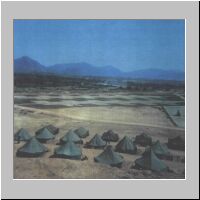
Lane Army Heliport June 1966. The photo was taken from the hilltop looking down on the airstrip (Notice the GP tents. No wooden structures yet). Photo courtesy of Bob Stuart.
Payback time evolved about a critical shortage of oxygen and acetylene needed to weld and repair engineer equipment. Normal supplies had been reduced due to the shortfall from Okinawa before the new plant at Cam Rahn Bay was up to speed. Other critical shortages, like beer and soda, also impacted operations!
Gene Teague and I provided a UH-1D for a scrounge run to Cam Rahn Bay and Nha Trang. The Quartermaster Depot at Cam Rhan Bay was manned by a second lieutenant who became "most helpful". Not only were we able to exchange our four empty canasters for full ones for the engineers, but we also aquired a case of gate valves and fittings for our water system at Lane. Next stop was Nha Trang to pick up mail and distribution from 17th Aviation Group. Upon leaving the S-1 office, we noticed a cache of galvanized water pipe lying in the grass (weeds). Since no one in the S-1 shop claimed ownership, we borrowed their three-quarter ton truck and transferred the 20' bundles of pipe to the airfield. While we were securing the pipe to the aircraft skids, the rest of the crew arrived. They had visited the 5th Special Forces group across the airfield and had eight cases each of soda and beer! It was a cramped and heavy 'copter; the takeoff was bumpy and climbing to cruise altitude seemed to take forever. Landing at Lane was reminiscent of our initial arrival from the USS Point Cruz.
One of our visits to Pleiku for temporary gunship support turned, literally, into a "blood and guts affair." We were virtually at tree top level due to the overcast when a flock of birds exploded just ahead of us. One of the feathered friends entered the cockpit through the chin bubble, spread himself thin all over. The ensuing blood, guts, and feathers broke the tension and later got a few laughs.
My letter to BG Robert L. Scott, Jr., was drafted aboard the USS Point Cruz after I read Scott's "God Is My Co-Pilot." The request to use the famous Shark's teeth of the Flying Tigers was typed at Lane on 14 June 1966, and mailed. Scott's response of 28 June 1966, received on 4 July 1966, granted the 174th gunships permission to use the famous insignia; the only unit in RVN so authorized. Copies of Scott's letter have been reproduced countless times. It is in the Department of Army archives. The original is in my family as a treasured momento of his 1966- 67 tour. Coincidentally, the famous Flying Tigers were unceremoniously disbanded on another July 4th in 1942. That is another story in itself!
The origin of the shark's mouth dates back to 1941, as documented in the Champlin Fighter Museum at Falcon Field, Mesa, Arizona. An American Volunteer Group pilot, Charlie Bond, was visiting the home of Roy and Alice Klein, American Baptist missionaries in Toungoo, Burma. Bond noticed their copy of the Illustrated Weekly of India, dated 2 November 1941, had a picture of a Curtis P-40B Tomahawk with a shark's mouth decorating the nose. The aircraft belonged to the RAAF #112 Squadron. The next day, 16 November 1941, Bond rode his bicycle into town, bought some paint, and by that afternoon, had marked his P-40B in the manner subsequently adopted by the AVG as the trademark of the "Flying Tigers." There were 13,738 P-40s built and used by twenty-eight countries. The last version was the P-40N. The British called them Tomahawk or Kittyhawk. The USA named the P-40 "Warhawk." Champlin Museum has one built in 1944 with fewer than sixty flying hours on the aircraft.
The Time-Life book series Epic of Flight, Soldiers of Fortune, chapter 3, "Tigers in the Asian Sky," pages 73 through 107 presents an interesting portrayal of the American Volunteer Group, i.e., The Flying Tigers.
The German Luftwaffe had a squadron of twin engine Messerschmitt bombers (ME-110) in the Mediterranean theater during the initial stages of WWII. They were known as the Haifischgruppe or Shark Group whose aircraft nose was also decorated with the gaping shark mouth. The Champlin Fighter Museum has a pictorial display of the aircraft and some squadron pilots. Erick Shilling claims this was the original source for the P-40 Shark mouth.
The Service Platoon was assigned the UH-1C helicopter by the company T.O.& E to be used for transportation of maintainence personnel in aircraft recovery- and for parts runs. The tail number of this aircraft was #65-09425. It was rarely used for it's intended mission, so it was modified to carry a M-3 rocket launcher system (obtained from the ARA battery, 1st Cav Division at An Khe)
The M-3 system consisted of two, 24-round pods of 2.75" rockets. Once the system was mounted on the aircraft, it was flown to Vung Tau for electric circuit modifications, checked out, test-fired and certified as operational. It was given the name "HOG" from that day forward and was used only for LZ preps and maintenance runs.
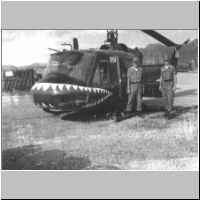
August 19, 1966 Lane Army Heliport. The first gunship to "sport" the Shark teeth! #65-9425 had an M-3 system (twenty four 2.75" rockets on each side!). Left: SP5 Clif Hulsman- Crew Chief. Right: Major Dick Overhamm- Platoon Commander. Photo courtesy of Dick Overhamm
The "HOG" was the first Shark painted by Jim Coyne, the assigned gunner. He should elaborate on his artistic accomplishments as well as the crew chief, SP5 Clif Hulsman. The "Colgate Smile" made its debut on 19 August 1966. Others were painted as Coyne's time permitted.
Another Shark UH-1C, #65-09424 equiped with the M-5 (40mm HE), was modified at Lane with a metal chute extending upward from the console. This enabled us to expand our basic load four or five fold. The added weight made it a bit nose-heavy but it sure extended our time on target significantly. Of course, a stray incoming round could have started some nasty fireworks, not to mention a bad crash and a fire made more dangerous. "Sin loi!"
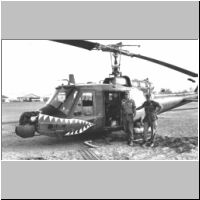
August 28, 1966 Nha Trang. UH-1C "540" #65-9424 with M-5 system (40mm nose turret with two seven round 2.75" rocket pods). Left: SP5 Art Mesecher- Crew Chief. Right: Sgt. Dexter Frisby- Gunner/Squad Chief. Photo courtesy of Dick Overhamm
Captain Bill White was one of those who came over to the 174th from the 161st AHC in the DEROS shuffle. He was a short-timer but his experience and accuracy with the M-5 was obvious. Those of us who have fired it can appreciate the lead and Kentucky windage required.
Another 161st transfer was Captain Gary Loban (deceased 17 July 1997), an experienced gunship pilot and reputed to be a gunsmith/armorer in civilian life. I remember his liaison with USAF C-130 gunship people in Nha Trang, and coming back to Lane with a pet project designed to "reach out and touch somebody" with a 12.7mm. Gary's idea to mount a 20mm cannon on a UH-1C was very appealing. It would make a great combination with the Cluster Light project to hunt sampans off the Phu Cat coastline. Only drawback(s) were (1) the muzzle blast raised hell with the chin bubble Plexiglas- and the crew's hearing- and (2) the flexibility of the skids precluded the stable gun platform required for accuracy. We dropped that idea rather quickly!
The Cluster Light project was designed and fabricated in Saigon. It consisted of a series of C-123 landing lights mounted on a flexible circular frame which could be telescoped to concentrate a beam of light from varying low altitudes. The feedback reflection was rough on the "Glowworm" or "Firefly" crew but the escorting gunships had illuminated targets to engage. The Cluster Light was rotated among various aviation units but when it came time for the 174th Sharks to play with it, higher authority precluded its employment. It might have reduced the local VC sampan fleet considerably.
I can't recall exactly how or when I acquired some extra insurance in the form of a Thompson .45 submachine gun with two taped magazines. Perhaps from some grateful 5th Special Forces or SOG type, but I recall packing that heavy sucker and suspending it from the side panel of the armor seat. If we ever went down and had a close encounter of the VC type, it certainly would have helped. Perhaps some of the Shark crew chiefs or gunners can elaborate. Eventually, one of the Tiger Division ROKs conned me out of it after watching me play with tin cans on their firing range. By then I had left the guns and was the 14th CAB LNO (Liaison Officer) to the ROK Division (effective 23 September 1966).
One of our VIP missions envolved three Shark gunships escorting U.S. Navy and Australian brass to view an amphibious assault into VC territory south of Nha Trang. We landed on the carrier USS Princeton amidst concerns about our carrier qualifications. Obviously they were unaware of our "combat qualifications" with the USS Point Cruz and the hostile beaches of Vung Tau during April 1966! As soon as the main rotor blades were secured, we were mobbed by Marine pilots and their crews. They were in awe of our clean UH-1C "540s" and the weapon systems. It must have seemed like Christmas at an orphanage! We were the "haves" and they were the "have nots". A close look at those patched- up Marine H-34s with the pedestal and/or the hand held M-60s made us proud to be Army Aviators and very appreciative of what Uncle Sam had provided for us to fly. The Marines certainly appeared to be the Navy's stepchild. This particular mission was to play a prominent role in the Shark's effort to retain their trademark.
During the latter part of August or early September 1966, a 1st Aviation Brigade directive, initiated by BG Seneff, prescribed the regulation OD (Olive Drab green paint) and black for all Army aircraft - no more fancy insignia and cowboy stuff! We only had two or three gunships remaining to be painted. General Seneff, on a visit to Lane AHP (Army Heliport), met with Lieutenant Colonel "Black Sam" Kalagian and was shown BG Scott's letter authorizing the "Colgate Smile." Seneff relented and the remaining Sharks were painted. Unknown to "Black Sam", while he was meeting with Seneff, the general had been complimented earlier for a VIP escort we had performed. It seems some U.S. Navy and Australian brass were much impressed by their Shark escorts. The gunships are impressive in formation! The old timers, however, did not appreciate our singular status.

L-R: Dick Overhamm, Marty Heuer and Henry Rust working on the shower. From tents to hootches in late 1966! Photo courtesy of Bob Jones.
One VIP escort mission out of Nha Trang, as witnessed and related by Jim Coyne, involved General Westmoreland. "Westy" was not too impressed by "those damn teeth" and upon landing had a discrete conversation with me. Fortunately, the impact of BG Scott's letter of authorization and the legend of Chennault's Flying Tigers was reason enough to "carry on." Jim had occasion to reconfirm the incident with Westmoreland at a convention dinner in 1982.
All was not sweat, scared, and "hitting the fan." We had some lighter moments also. The Stars and Stripes had published bits of pulchritude occasionally to boost moral. One of the beauties was "Miss Bikini 1966," Charlotte Davidson of Upper Montclair, New Jersey. She was simply gorgeous, a blonde aspiring model and actress (naturally), and needed a sponsor to try and get on the Bob Hope RVN Christmas show tour. She was the sort of girl you'd bring home to mother, or rather would like to, except father would probably take her away from you. My letter to Mr. Hope failed to earn Charlotte a spot but each Shark gunship had an 8x10 photo on the aft cabin wall; for awhile at least! It was a reminder of what every red-blooded Army aviator and crewman wanted the girl next door to be. She must be in her 50's now and probably has a bunch of kids. Oh, Momma! I wonder if she would attend one of our reunions? I tried during April and June 1999 to contact Charlotte and her modeling agency but was unsuccessful.
The Khe Sanh tours were the hottest experiences of my three trips to RVN. Sometime during July and until mid-September 1966, a pair of Shark gunships was sent TDY to support the SOG element operating out of the Khe Sanh airstrip. Aircraft are hit occasionally by ground fire but no casualties are sustained. Replacement gunships were rotated out of maintenance at Lane (Phu Tai) as needed so as to maintain a pair of operable gunships at Khe Sanh. Whenever one or two replacements would fly in they would join in the fun and games. There was never a dull moment at Khe Sanh. It later developed into a bloody affair.
One mission in particular during the morning of 28 July 1966, stands out in my memory to which P.T. Yowell can attest since he was my wingman. We had volunteered for a SOG mission to recover five casualties and ran into a hornet's nest - a suspected VC/NVA regimental headquarters size unit. On our initial low pass, the gunner, SP4 Ray Haddon, reported eight or nine continuous flashes (automatic weapons) which he marked with a smoke grenade. The USAF FAC (Forward Air Controller) confirmed the sightings. We made two gunruns and backed off taking only two rounds in the tail boom. Then the FAC began his show. The fire power unleashed on that terrain was awesome. The FAC had A-1Es, OV-10s, and a C-130 gunship stacked up and on call. I assume a battleship was off shore, and on call also if needed and within range, as in other coastal engagements. After the air strikes we made a few runs on the target boundary and returned to Khe Sanh for refueling, rearming, etc. That afternoon we returned with a VNAF (Vietnamese Air Force) H-34 to recover the five bodies originally spotted that morning. In spite of being booby trapped, the remains were recovered. Only light sniper fire was encountered which the gunships subdued. The mission was completed without further incident.
The Shark crews involved were submitted for a Distinguished Flying Cross (DFC) for valor but the awards apparently were not processed to completion; lost in a paper shuffle somewhere!
Major Overhamm, AC
Captain Loban, AC
WO Lawson, P
CWO Yowell, P
SP4 Mesecher, CE
SP4 Hulsman, CE
SP4 Haddon, G
Sgt. Gonzales, G
Our own Lieutenant Dale Wylie pulled off a one-in-a-million shot during a gunrun out of Khe Sanh. I was trying to destroy a cable crossing over a swift stream astride a supply route. I failed to take out the anchor points on either side, huge trees, with 2.75" rockets. Finally, Dale tried his hand with the 40mm grenades. On the second run, a 40mm grenade round hit the cable midstream and it snapped. Ever try splicing a taut cable in its center span? Charlie must have wondered who, how, and when!
Most aviators do not realize the logistical requirements created by busy gunships. During my "vacations" at Khe Sanh it was common for one or two USAF C-130 aircraft to deliver pallets of 2.75" rockets, 40mm grenades, and 7.62 ammo weekly! That was in addition to what we carried in loaded systems and internal extras as we returned from Hue Phu Bai each morning. We were so heavy we'd have to make running landings on the PSP (Perforated Steel Planking runway) at Khe Sanh and unload the extra goodies before engaging any local targets. A written report dated 10 August 1966, addressed to the Special Forces commander at Khe Sanh, listed the participating Shark crews during the period 20 July to 7 August 1966. It also reflected 158 flying hours and an ammunition expenditure of 570 2.75" rockets, 1900 40mm grenade rounds, and 48,100 rounds of 7.62 bullets. Things were never dull at Khe Sanh.
Crews were sent from Khe Sanh back to Lane to clean up, etc. Then they were rotated to Nha Trang with clean, mission ready aircraft. The R&R in Nha Trang was supposed to be a well deserved break after the demands of the extended SOG missions. The duty at Nha Trang included flying VIP escort, unscheduled interdiction missions in the free fire zone to reduce Viet Cong tax collector activity, as well as local MACV (Military Assistance Command Vietnam) sector and Special Forces support. However, our lucky streak was broken during this "easy gunship tour!"
On 28 August 1966, the Sharks sustain their first casualty when crew chief SP-5 Charlie Gregorski is wounded by an exploding rocket. The gunship team was on a support mission north of Nha Trang. The gunner was SP4 John Pum who was to contribute significantly six days later. The remainder of the crew probably included Lieutenant Bob Bryant and Chief Warrant Officer (CWO) Perry Yowell. Gregorski was medevaced to Nha Trang, then to Japan, CONUS, and eventually to Valley Forge Hospital where our blonde mascot, Charlie Davidson, attempted to visit him.
A week later, on 3 September 1966, a Shark light team was dispatched by MACV to support C Company 1/327 Infantry, 101st Airborne Brigade north of Nha Trang, along the railroad near Ninh Hoa. The friendly unit had encountered a well positioned Viet Cong force of unknown strength with several automatic weapons. C Company had sustained several casualties and was dispersed along a wide front. We made a total of five firing passes; initially abreast and parallel to C Company's front, to hose down the VC and subsequently, in the conventional echelon formation, to engage point targets. The hostile fire subsided with each gunrun. However, on the fifth run the lead ship took several hits seriously wounding the crew chief, SP5 Jack Hester, and to a lesser degree the gunner, SP4 John Pum. Pum administered first aid while in flight. We disengaged with a "good job, thanks" from C Company and headed for the hospital pad at Nha Trang. The medics, accustomed to slicks, became very upset when a gunship landed on their pad! C Company later reported twenty-seven VC killed in action during the operation. The Shark crews submitted for the DFC for this action involved:
Major Dick Overhamm, AC
Lieutenant Bob Bryant, AC
Captain Bill White, P
CWO Perry Yowell, P
SP5 Jack Hester, CE
SP5 Bob Long, CE
SP4 John Pum, G
SP4 Ray Haddon, G
The Purple Heart was awarded to SP5 Hester and SP4 Pum. This was Jack Hester's second tour in RVN. He was a genuine "short timer" when he was sent from Lane AHP to replace SP5 Charlie Gregorski who had been wounded a week earlier. John Pum had volunteered to come to the Sharks from the 101st, perhaps for an easier and safer tour. John - your comments please!
Incidentally, as an aside, the doctor who met us in his blood-stained white coat was to become the hospital commander at Hunter AAF, Savannah, Georgia, where I was subsequently stationed. Toni delivered our oldest son, Eric, there by natural childbirth with me attending - a first at Hunter. The "baby" is now nearing thirty years of age and bigger than his father.
During the summer of 1966, stories circulated about 2.75" rockets becoming erratic, with reduced trajectories and warheads separating from the rocket body in flight. The Ordnance Corps, the manufacturer, and gunship crews depending on the ammunition were justifiably concerned. The wounding of SP5 Gregorski on 28 August 1966 increased our worries.
Several days after Jack Hester and John Pum were hit outside of Nha Trang, we were again on a hot run. One of the first of two pair of rockets caught our attention. The port-side rocket broke up upon leaving the launcher with the warhead breaking away from the rocket body, tumbling and ricocheting off the port-side skid! The second pair fired normally. Shades of Gregorski - here we go again.
On a subsequent mission, the port-side rocket of another pair ignited, partially exited the launcher, and hung up, cracking the rocket motor body and jamming the rocket at a downward, inboard angle. Now we had something for the Ordnance folks! Upon landing, the warhead was removed and the remainder extracted from the launcher. The firing circuits were checked and found to be OK. Coincidentally, one of Jack Hester's hospital wardmates was an Ordnance Colonel in Vietnam to research the 2.75" rocket problem. He was scheduled to return to CONUS shortly. Needless to say, he was elated to receive our souvenir and get the facts first hand. Most people in the hospital get flowers!
We encountered no additional malfunctions thereafter but heard subsequently that the problems were caused by defective solid propellant motors - a manufacturing problem.
During my tenure as the 14th CAB liaison to the Capital ROK Division and well into the monsoon season of 1966, a recovery mission developed to extract a large number of Korean infantry. The operation was located northwest of the Phu Cat mountains in rather flat and open terrain. Due to the heavy rain and deteriorating IFR conditions the primary pickup zone was relocated. While the troops were en route to the alternate site the weather worsened. The ceiling dropped to less than 100 feet and visibility perhaps an eight of a mile. Since I was the LNO and had nothing else to do that day, I volunteered (MISTAKE) to act as a Pathfinder GCA type to facilitate the operation. Some gung-ho slick driver flew me in with some portable lanterns to outline the pickup area (practically useless) and a radio. I then talked pairs of slicks into the pickup zone since I could hear them approaching well before they could discern the area. The recovery operation came off without incident; no close calls and no one hurt. But for awhile at least, before the first ROK's arrived, it sure got lonely out there!
The extensive daily resupply missions in support of the Korean units in our AO were a drain not only on available aircraft assets but also on the aviators. The stress of these missions in addition to the combat assaults, regardless of weather conditions, was compounded by the complications arising from the language barrier. To expedite on-site communication and improve resupply efficiency, a group of 17 Korean fixed-wing pilots on duty with the Capital ROK Division were incorporated as co-pilots on administrative resupply missions. They were not involved in CAs or gunship flying. To minimize the risk of an incapacitated U.S. aviator at the controls, it was decided to operate an in-country rotary-wing flight school for these ROK aviators. To enhance crew survival, these non-helicopter qualified pilots would be trained to take over the controls and complete an approach or an autorotation. A secondary benefit was the fact that upon completing their tour in RVN, these ROK aviators were destined for stateside rotary-wing school under the foreign military assistance program. This in-country exposure to a UH-1 would enhance their subsequent training although it was a quantum leap from the cockpit of an L-19 or L-20. Often misunderstood and underestimated, this group of 17 was under tremendous pressure to succeed. The Asiatic principal of "saving face" was at its zenith.
Since I was already involved as the 14th CAB liaison to the Korean division, the command element decided to put me in charge of this training effort. Fortunately, one of the Koreans, Captain Rhee, was partially fluent in English. That, plus my previous tour in Korea with CH-37s supporting Koreans, fostered a productive relationship. Captain Rhee was very instrumental in facilitating the training. In their eyes, my status as an instructor pilot in the UH-1 series and the former Shark gunship platoon commander put me on a pedestal - I could do no wrong. I had their undivided attention as well as the unqualified support of the division commander, BG Lew Byong Hion. Fortunately, several of the 174th pilots pitched in on a time available basis both in ground school and the flying phase. It was a group effort. Sadly, the program was marred on 17 December 1966 when a mechanical malfunction caused the crash of a UH-1D during a training flight with the loss of the American IP - Captain Aaron L. Bram, crew chief SP5 William L. Seastrom, and Korean pilot Lieutenant M.S. Lee.
The loss of these two Americans was especially poignant. Both had served with me during my tenure as the operations officer for the 5th Special Forces Group Aviation Company. Captain Bram had arrived a short time prior to my leaving for Benning and the 174th AHC. However, SP5 Bill Seastrom and I had weathered the ups and downs of aircraft availability for several months. He was a quiet, dependable individual who, in addition to his assigned UH-1s, often volunteered to work on our CV-1s and U-10s. When he arrived to join the 174th at Benning, I knew the unit had gained a highly qualified technician and soldier. We lost a good man on 17 December 1966!
The stress of flying administrative missions, their flight training, and translating the appropriate manuals was considerable. Visits by the Korean staff to "encourage" these aviators were detrimental to the point that I personally asked BG Lew to back off a bit. He understood and graciously honored my request.
The translated UH-1 manuals were forwarded to the Director of Instruction, U.S. Army Aviation School, Fort Rucker, Alabama for possible future utilization. We never heard from them.
The in-country flight school continued quite well in spite of a few bent stingers and spread skids. One of the altered skids belonged to Black Sam's C&C aircraft. The incident occurred while I was in the left seat. I recall a discussion that night regarding "my aircraft" in spite of the name "BELL" on the pedals and U.S. Army painted on the tail! Even IPs are not infallible Sam!
The Sharks continued a reputation up until deactivation in October 1971. Luck ran out for some of them and some were lost. Mike Campbell's letter of 6 February 1994, to Ted Saunders relates an article via a Japanese magazine and subsequently by some POW's, about a mangled Shark hulk on display in the Imperial War Museum in Hanoi. Probably a result of action in the DMZ (Demilitarized Zone) during operation Lam Son 719 during the February-March 1971 era.
During my subsequent tour in Headquarters, MACV in 1973, I heard stories about a bounty having been placed on Shark gunships. We must have put "a hurt" on someone. During the June 1988 through June 1991 period, Jim Coyne was stationed in Rangoon, Burma, employed by CBS. He had dinner with the Vietnamese Ambassador to Burma, a former NVA (North Vietnamese Army) Colonel stationed at Quang Ngai, who remembered the "horrible grinning teeth." He had posted a bounty for anyone who could bring one down. The Ambassador confirmed the Shark on display in the Imperial War Museum in Hanoi.
The captured VC claimed the two things which they feared the most were (1) the B-52 "Arc Lights" because you were not aware of your immediate fate until all those swimming pools were being excavated around you. The survivors were usually in shock and hard of hearing for some reasons associated with 500 pound bombs. And (2) the persistent helicopter gunships. Once you were spotted, the gunships were relentless until they ran out of ammo - and then usually they would be replaced by another team.
The enclosed copies of three letters should close the book as to how and when, reference the Flying Tigers insignia. The last letter does not complete my gratitude to BG Scott, Jr. I am working on a gift to present to him. We owe him a lot for obvious reasons. He is pushing ninety-one years of age and still active at the Museum of Aviation at Warner-Robins, Georgia. If possible, visit with Scott. As a former Shark you're in for a treat! (Scott's DOB is 12 April 1908)
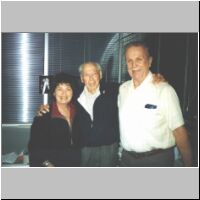
Toni and Dick Overhamm with BG Robert L. Scott Jr. (center) at Warner Robins AFB, Georgia October 15, 2002.
A recent PBS television documentary entitled "FEI-HU: The Story of the Flying Tigers," is a must-see for any Shark veteran. Needless to say, I made a copy.
The commercial artists have had a ball with this Shark affair. Joe Kline and Larry Lapadura of California have done some neat stuff. I hope Kline takes my hint and sends one of his masterpieces to Scott and the Flying Tigers.
The Franklin Mint has produced a copy of a Shark UH-1 ostensibly with authorization from the Vietnam Memorial Association. It's not cheap - my sons got me one for Christmas 1998. I attempted to con them out of one for Scott and the Flying Tigers, but the Mint ignored my request.
On 25 March 1999, I sent two separate mailings to BG Robert L. Scott, Jr. The first packet included some photos of Sharks which the old Flying Tiger would enjoy as well as reference to Marty Heuer's 174th AHC historical project; the Shark in the Hanoi War Museum; the bounty placed on the Sharks, and the planned reunion in October 1999. I also mentioned the pending visit to the Champlin Fighter Museum which contains a significant amount of Flying Tiger memorabilia.
Same date, separate mailing, I sent him three 11" x 17" color prints of a Shark gunship in flight and inscribed as follows:
"To BG Robert L. Scott, Jr. and veterans of the American Volunteer Group, the China Air Task Force; "The Flying Tigers."
Presented on behalf of all SHARK gunship crews with respect and appreciation of your achievements, our profound gratitude for the privilege of carrying your distinctive insignia into combat during the 1966-1971 era of the Vietnam conflict."
LTC Dick Overhamm, USA-Ret
Former "SHARK 6"
174th AHC, 14th CAB, 17th Avn Gp
|
A response from BG Scott, dated April 15, 1999, expressed his thanks for the Shark material recently received. He again underscored the fact that he was never one of the original Flying Tigers - "I just flew with them!" He became Chennault's commander of the 23rd Fighter Group, U.S. Army Air Corps, on 4 July 1942, which absorbed those civilian Tigers who chose to "rejoin" the service.
On 2 April 1999, I had the pleasure of meeting Mr. Bill Rummer, the Executive Vice President of the Champlin Fighter Museum located on Falcon Field, Mesa, Arizona. He had heard about the Shark gunships and BG Scott's letter of authorization. Mr. Rummer was very interested. I gave him copies of letters, photos, etc., duplicating what has been furnished to Heuer, Cobb, and Saunders, along with their respective addresses, the book project, 174th AHC Association functions, and the 174th AHC web site. He may contact any or each of us for more material. The Champlin Fighter Museum is a very large private collection of flyable aircraft dating back to pre-WWI and up to MIG-29, etc. There is a significant display of Flying Tigers material. There are no helicopters on display. Anyone have a UH-1C lying around?
Tail-End Note
July 1999 Update:
By indirect means and via an e-mail copy addressed earlier to the Champlin Fighter Museum, I was able, belatedly, to contact the Flying Tiger's Association recently. Their association president, Dick Rossi, graciously responded to my 12 July 1999 correspondence. Less our "younger" Sharks forget history, the original Flying Tigers in their P-40s took on the Japanese Air Force prior to Pearl Harbor at 25 to 1 odds. They destroyed at least 299 Japanese aircraft in aerial combat and more than 240 on the ground. Their living conditions were probably worse than ours ever were. Below is Rossi's reply:
FLYING TIGERS ASSOCIATION
American Volunteer Group - Chinese Air Force
John Richard Rossi
P.O. Box 2043
Fallbrook, CA 92088
(760) 728-4254
FAX: (760) 723-3156
http://www.flyingtigersavg.com
e-mail: stargrfx@connectnet.com
July 12, 1999
LTC Dick Overhamm USA (Ret)
4567 W. Echo Lane
Glendale, AZ 85302-6509
Dear Col. Overhamm,
Thank you very much for your letter of June 28, 1999. I was pleased to read about the 174 AHC "Shark" gunships and your group of warriors who manned them.
Like Gen. Scott, I am happy to know that the shark mouth has been used to such a fine purpose and is so esteemed that even the Viet Cong have placed it in the museum!
I'm sure that I speak for all of the AVG Flying Tigers when I tell you that we consider it an honor to know that your fine group of airmen used our nose insignia and that it was a source of inspiration for them. Nothing could please our group more and I will notify our membership (now down to 55) in our next bulletin.
At your coming reunion, please pass on my respect and admiration to all of your members. We will never forget the Viet Nam Vets.
Sincerely,
/s/
Dick Rossi, President
Flying Tigers Association
|
I subsequently mailed a 11" x 17" Shark gunship print, appropriately inscribed, to the Flying Tigers (similar to what we gave General Scott earlier on behalf of all of us). I also included pictures of Jim Coyne's artwork on #425 (HOG) and #424 (M-5).
A copy of Dick Rossi's letter is enclosed (see above). Note address, FAX, e-mail, and web site for the Flying Tiger's Association.
Jack Hester, a former Shark, and my crew chief, passed away on 26 July 1999 due to complications arrising from a virus infection. Jack would have turned 54 years of age on 30 August 1999. Jack had established contact with me several years ago through the 174th AHC Association locator list created by Fred Thompson and Ted Saunder's efforts. Our conversation occured just a week before Jack's demise. Tentative plans were discussed to attend the October 174th AHC Reunion. Jack was an upbeat individual; a very conscientous and competent crew chief. He was a credit to the 174th Sharks. We'll miss him. Our condolences go out to the Hester family in Fairfield, Ohio.
I hope no one misinterprets anything I've done as grandstanding - none of this pays my bills! To the contrary. Since Marty Heuer, Ted Saunders, Bernie Cobb, etc. have prodded me into this project the kitty has taken quite a hit for reproduction, postage, phone calls, etc. not to mention time and effort. But it's well worth it. We need to record what was done and give credit where credit is due. I feel we owe a debt to those of us who flew the "teeth" and are no longer with us, as well as those who kept us airborne and entrusted their safety to our judgement and flying skills. Certainly our famous predecessors who created a legend and permitted us to share a brief moment in the limelight are owed our respect and thanks.
Comments anyone?
Epilogue
This ends the account of his days as a Shark in Vietnam. Overhamm added a personal note:
"Bernie, Marty, Ted, etc., I hope this fills in a few gaps or at least some of the highlights for the Fan Club. After thirty-three years, memory fails me somewhat, but then I wasn't concerned with taking notes or pictures over there. Rather, trying to stay in touch with the BIG SHARK up stairs and hoping HE wouldn't bite me in the ass too soon!"
/s/ Dick 10 May 1999
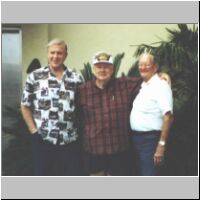
"Old Warriors"
October 2002, 174th AHC Reunion.
Left to right: Dick Overhamm, Bob Jones and Bernie Cobb.
|











